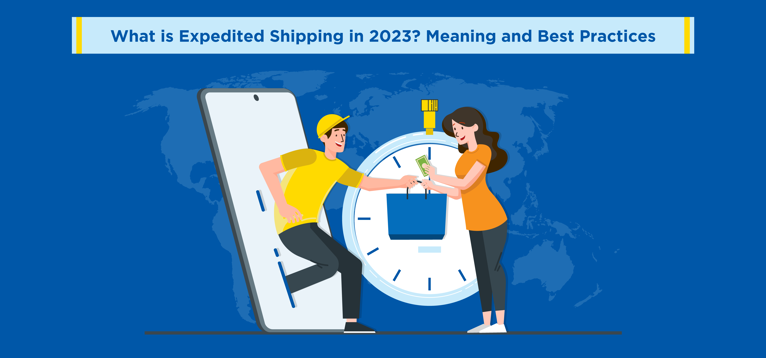“Fast and furious.”
What comes to your mind when you read this phrase?
We live in an era where this phrase is not just a movie reference, but a principle that time-scarce millennials live by.
Be it coffee, noodles, or the delivery of their favourite goods, everything must be instant. The faster something happens, the more it gets appreciated.
This trend applies to the eCommerce industry as well. Amazon has gotten shoppers used to the idea that pretty much everything could be and should be delivered within the span of two days or less.
Did you know?
- In a global survey, 77% of customers state that they have abandoned their online purchases due to unsatisfactory shipping options.
- Another 58% stopped shopping with particular retailers solely because of negative shipping experiences.
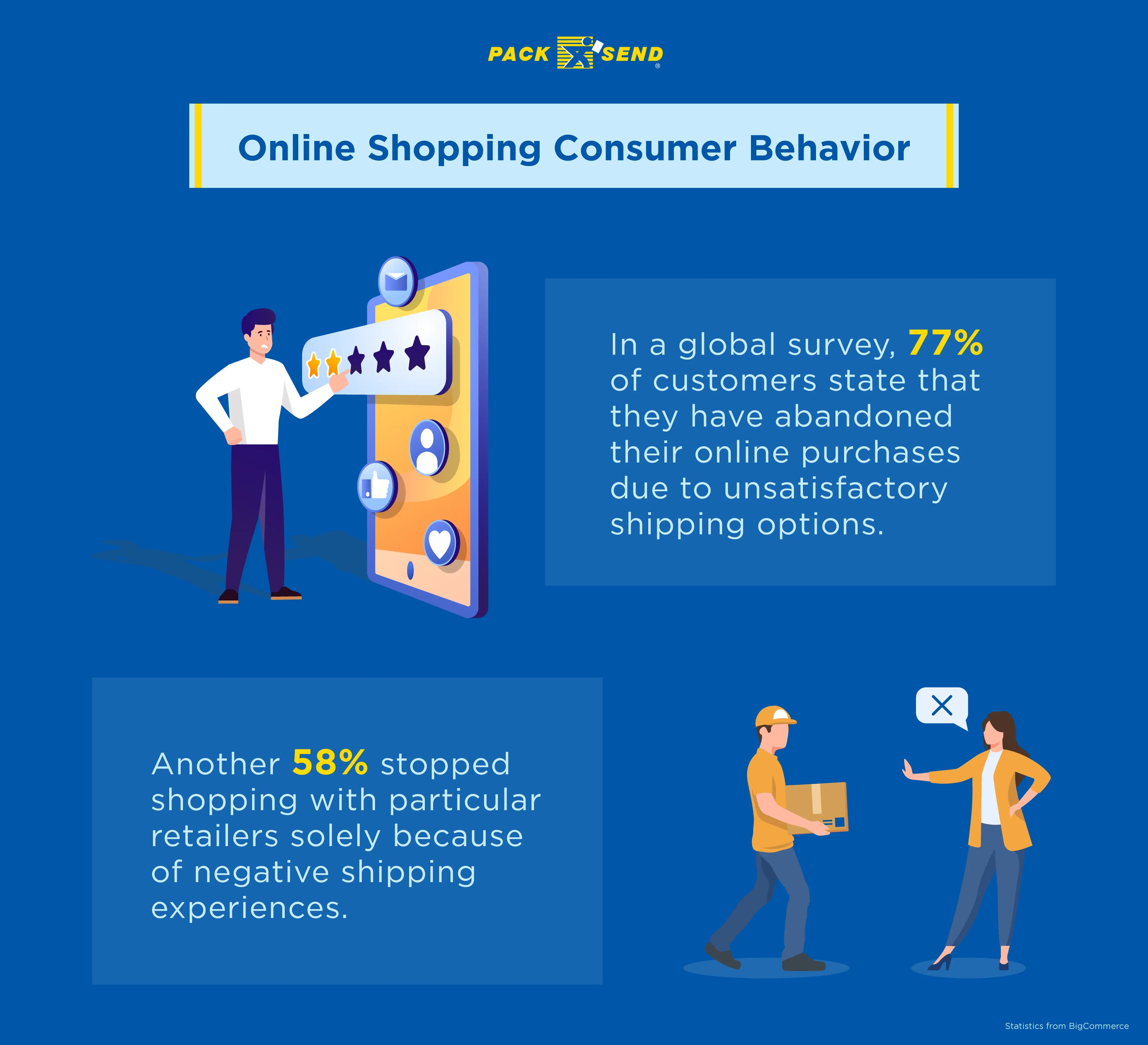
Besides, the Covid-19 pandemic has fast-tracked the digital transformation. It has altered consumer behaviour such that expedited shipping has now become a must-have delivery option for eCommerce brands.
Clearly, the customers attach value to expedited shipping. Given its compelling value proposition, the demand is only expected to increase.
As a result, an increasing number of eCommerce brands have started piloting and operating the model of expedited shipping.
This article examines the opportunities in the current landscape of expedited shipping, the benefits, the future scope, and the challenges that eCommerce players will need to overcome. Let’s get started.
What is Expedited Shipping?
Expedited shipping is an umbrella term for shipping freight that promises faster shipping speeds as compared to the standard transit timeframe.
It is when a particular parcel or consignment is prioritised at the request of the customers.
Many consumers believe that expedited shipping takes around 2-3 days, but the exact amount of time can vary depending on several factors, such as
- The choice of the shipping carrier.
- The package’s origin and destination locations.
- The resources of the eCommerce brand sending the shipment.
Expedited shipping usually encompasses
- Express deliveries
- Next-day deliveries
- Same-day deliveries
However, for many eCommerce businesses, ‘expedited shipping’ simply means the range of services that provides a faster delivery speed than the standard ‘three working days’ rule of thumb.
For example, FedEx offers three priority express delivery choices across all postcodes in Australia — by 9:00 am, 10:00 am, and 12:00 noon on the very next day. Whereas DHL offers 9:00 am and 12:00 pm next-day priority delivery options internationally.
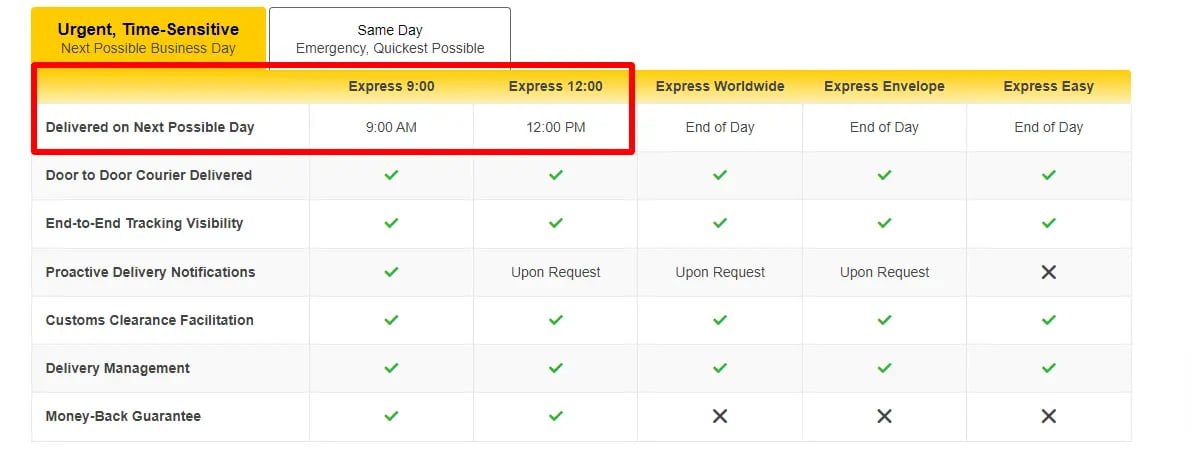
Similarly, local services like Pack&Send offer choices to get your packages delivered before 9:00 am, 10:00 am, and 12:00 pm the next day as a priority expedited delivery service across Australia.
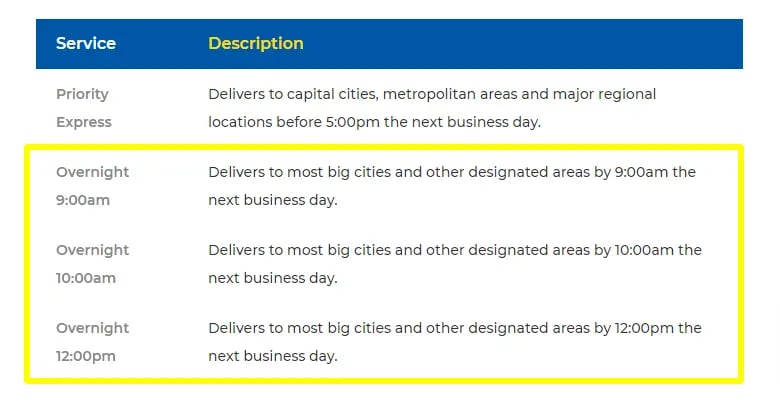
How Does Expedited Shipping Work?
In order for packages to arrive faster, the shipping carriers need to make few or no stops during the journey. Carriers that fulfil expedited delivery demands travel directly from order pickup to delivery and rarely stop along the way.
In some cases, packages are sent with two truck drivers who can easily switch shifts.
If direct delivery isn’t possible, carriers will organise routes through micro-fulfilment methods. This means that the delivery carriers can make multiple stops along with an extensive network of small-format fulfilment facilities located in accessible urban locations.
Carriers also offer expedited shipping tracking as a bonus, so that sellers and customers can keep an eye on their orders and make sure everything is going smoothly.
How Fast is Expedited Shipping: Brief Comparison
Expedited shipping standards might be different for different eCommerce brands. One online brand’s expedited shipping timeline might be standard for another.
The delivery methods and logistics costs also vary depending on the eCommerce fulfilment strategies. Here’s how expedited services compare to other shipping and delivery times.
Standard vs Expedited Shipping
For any eCommerce brand, expedited shipping will always take fewer days to ship as compared to standard shipping.
Here’s a brief comparison between both:
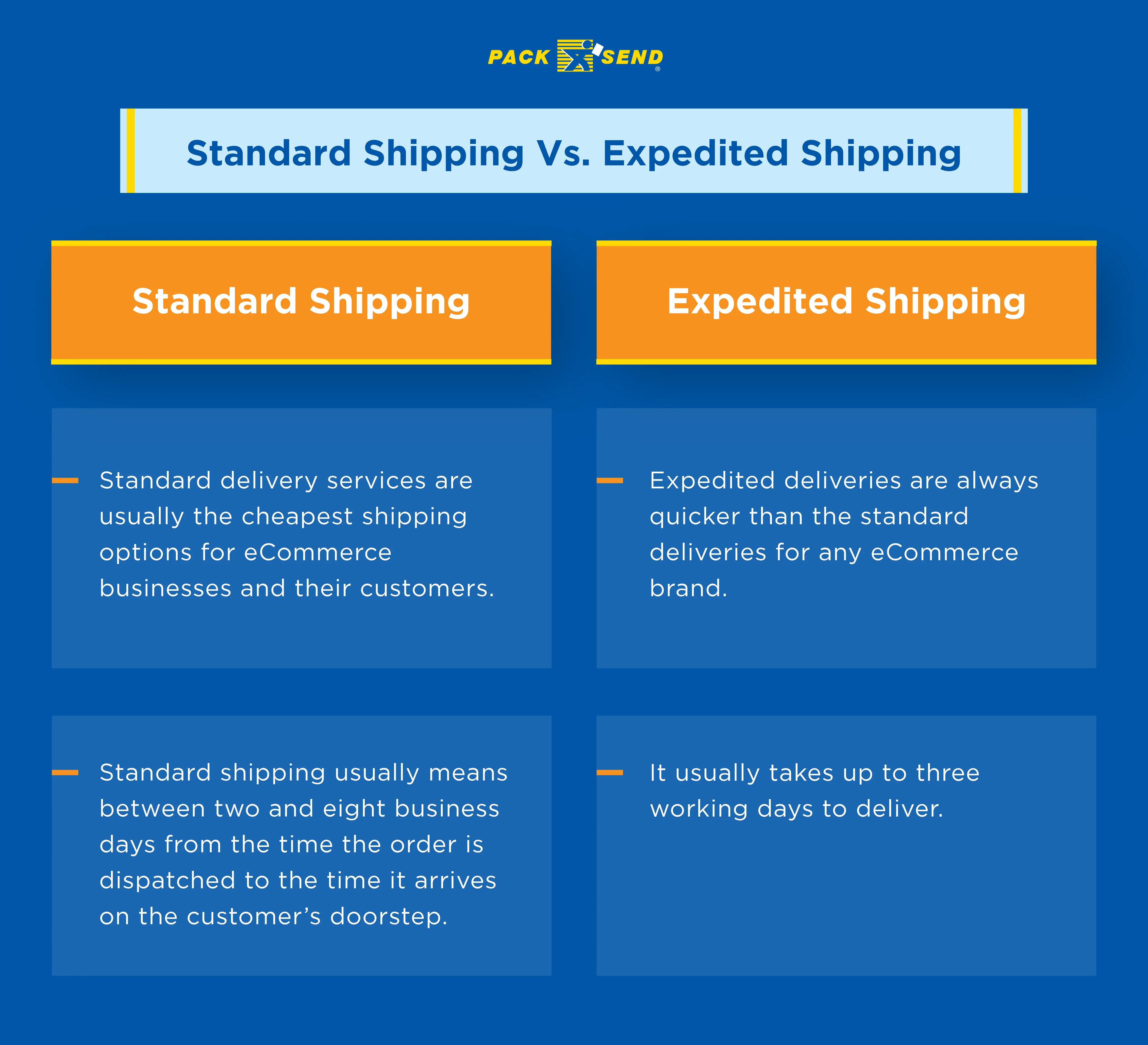
Express Shipping Vs. Expedited Shipping
Depending on the eCommerce retailer and carriers involved, expedited shipping and express shipping can have multiple meanings and are sometimes used interchangeably.
However, express shipping usually offers a guaranteed delivery date since you’re paying extra for the parcel to be delivered. There’s a very minute difference between both:
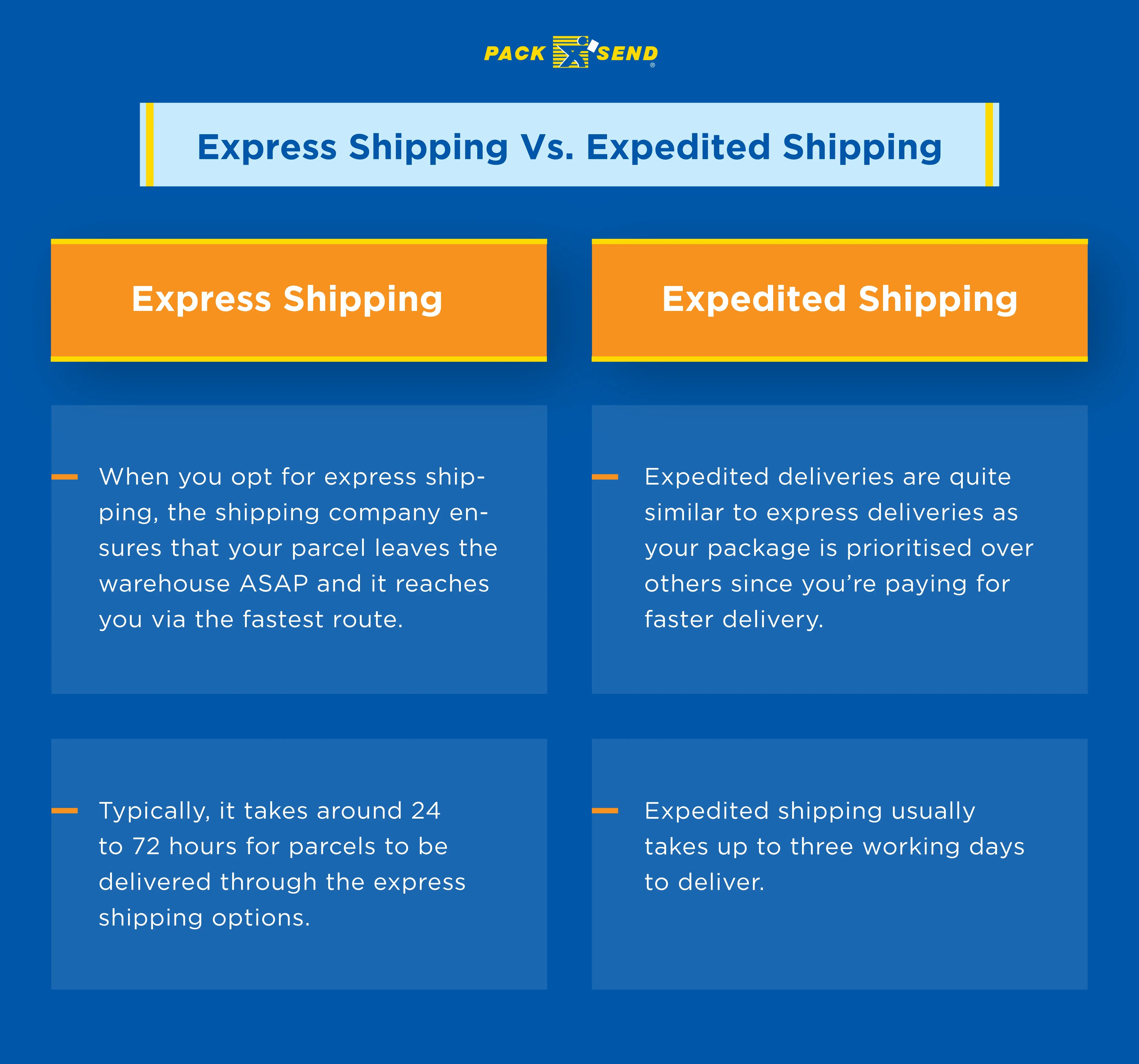
Two-day and Overnight Shipping
The global same-day delivery market is forecasted to reach 26.4 billion U.S. dollars by 2027.- Statista
Some retailers consider a two-day delivery or overnight shipping as premium expedited shipping options. While others consider them as standard shipping. The way these terms are positioned varies from brand to brand.
The omnipresence of services like Amazon Prime, FedEx, DHL, etc. has made the expedited shipping offering a necessity for eCommerce stores, whether as a standard option, a special perk, or something in between.
Why Should you Offer Expedited Delivery?
Consumer Expectations
Being the final step of an online order lifecycle, shipping holds more significance to modern-day consumers than we may accredit.
41% of customers are willing to pay the extra charge for same-day delivery.
24% of them said they would pay more to receive packages within a one-or two-hour window of their convenience.
Source: PWC Survey on Consumer Insights, 2021
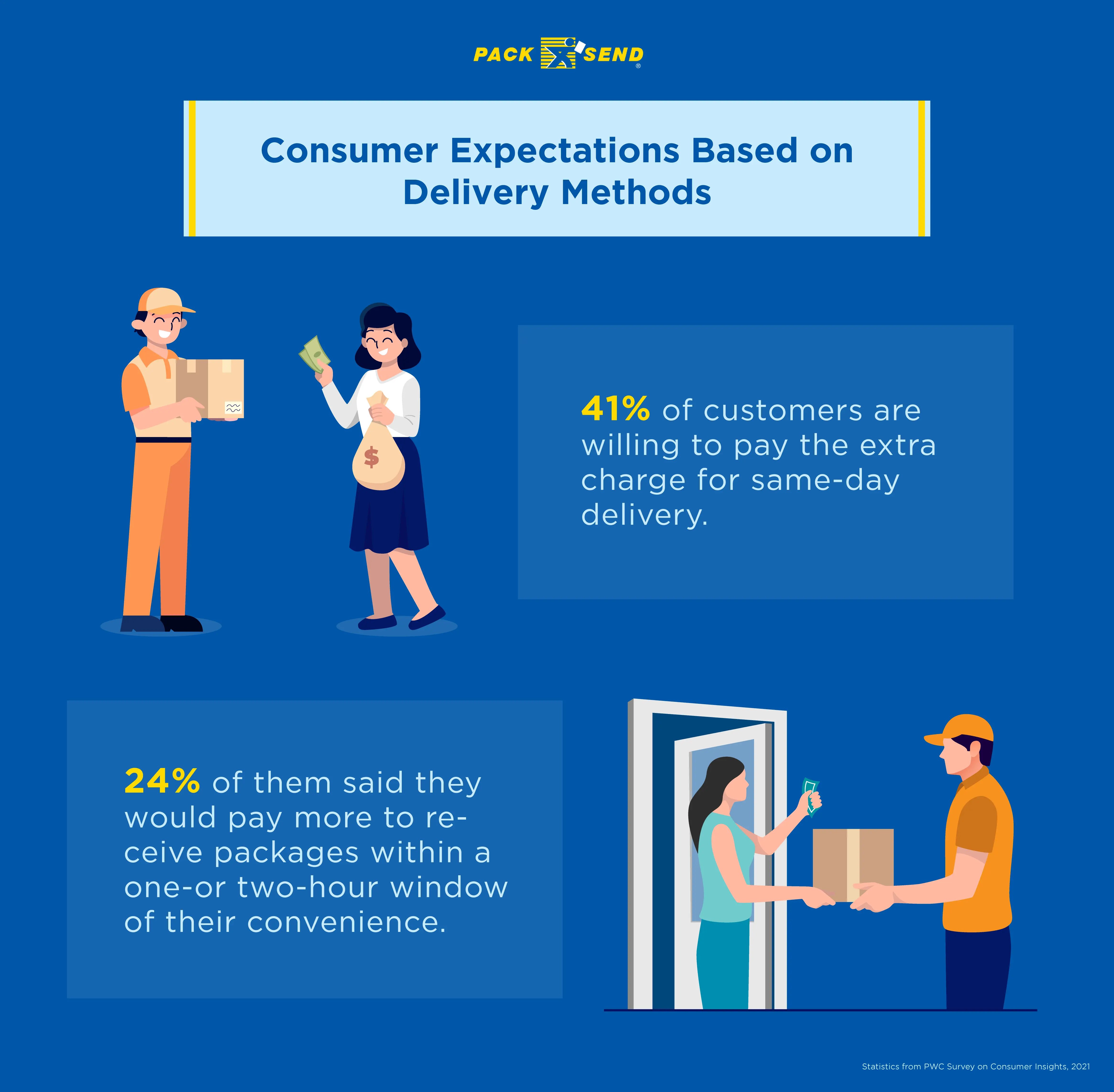
Back in 2005, when Amazon Prime was launched, the two-day shipping seemed like a novelty and was pursued as an indulgent luxury. The convenience of two-day delivery forever changed customers’ shopping habits.
It opened up the world of online sales to an entirely new range of product categories from everyday essentials to perishable products – even groceries.
Fast forward to 2022, customers are flooded with multiple shipping choices that seem more like a necessity than bonuses — Express. Next-day. Same-day. In simpler words: expedited delivery is the new norm.
All the other considerations are less important. Hence, offering expedited delivery becomes crucial.
Why do the Big Guys Win?
Amazon completely redefined everyone’s understanding of fast shipping. Shoppers know exactly what to expect when they’re placing an order from Amazon. Some reasons behind its success include:
- Their shipping policies and delivery fee remain the same throughout. — Amazon is nothing if it's not regulatory.
- The key reason is that customers know that their orders will ship out quickly. — Their ship-by date approach is a major driving factor of what has gotten them here.
- Their delivery ETAs are extremely accurate and rarely miss the date.
These factors collectively corroborate Amazon's success and are vital to its growing brand image.
7 Key Benefits of Expedited Shipping
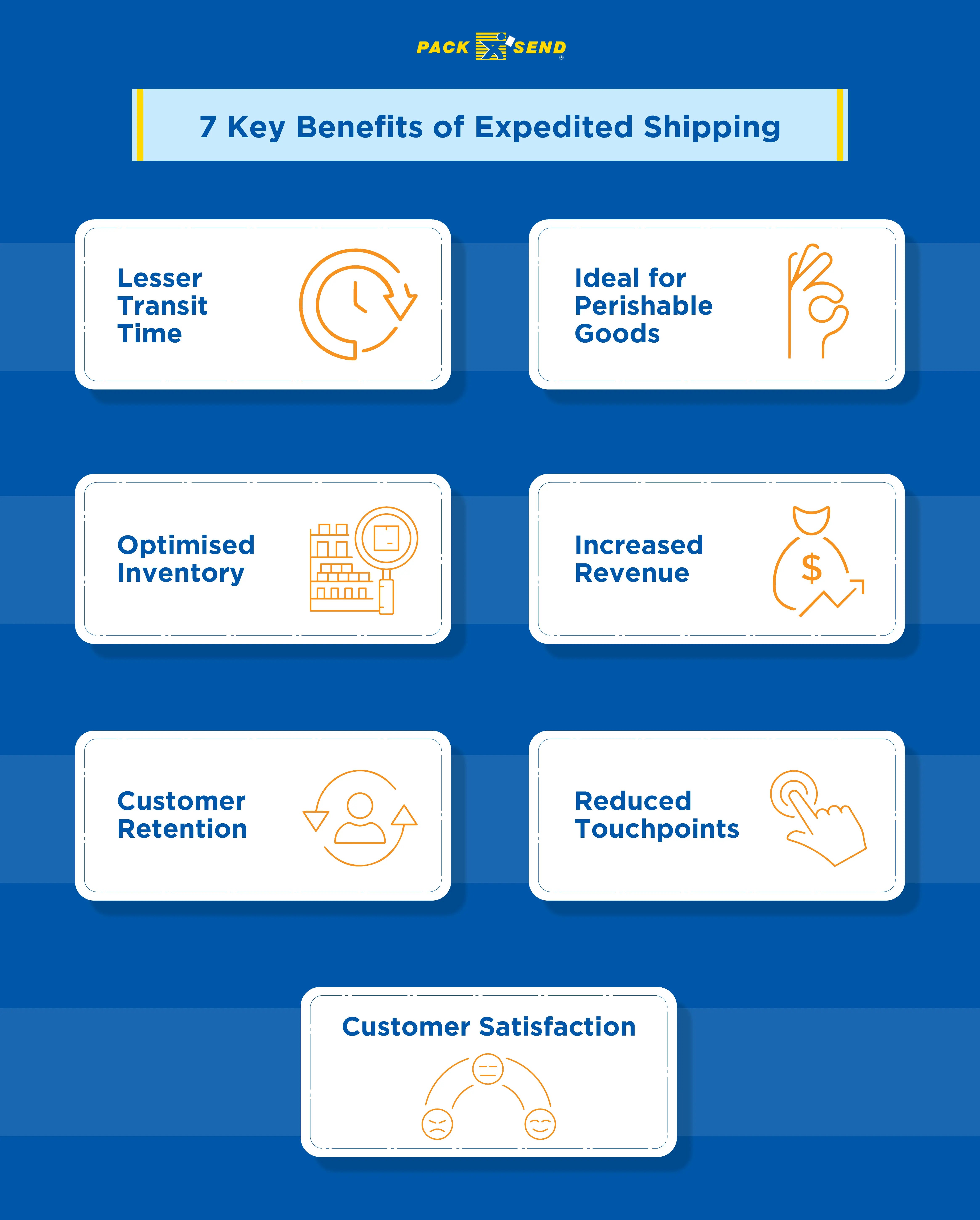
Look at a few other reasons why expedited shipping is beneficial for both eCommerce businesses and customers.
1. Lesser Transit Time
Saving the transit time is the primary purpose of expedited shipping services. Untimely deliveries can severely tarnish your business’s reputation. Especially when you’re shipping it through international courier freight.
In most cases, customers don’t have an issue with paying extra. This means that money is a lesser concern as compared to delivery time and convenience.
2. Ideal for Perishable Goods
Expedited shipping is ideal for perishable items – like frozen food, fruits, vegetables, meat, cheese and other dairy products that require fast shipping.
These perishable goods may expire while in transit if a company uses traditional shipping methods.
Through expedited shipping businesses can ensure that perishable goods arrive at their ultimate destinations while still viable.
3. Optimised Inventory
Expedited shipping may allow businesses to maintain their inventory by reducing the number of products they store within their facilities.
As soon as the customers purchase a product, the company may use expedited shipping to restock quickly.
Besides, your goods spend less time in your inventory. This saves the cost of inventory storage.
4. Increased Revenue
Shipping time directly or indirectly affects the revenue. Firstly, it encourages more customers to purchase the products since they know they can get them quickly.
Fast and efficient shipping boosts customer satisfaction. It also incentivises customers to purchase from your business instead of purchasing from your competitors. Here are some interesting stats about the same:
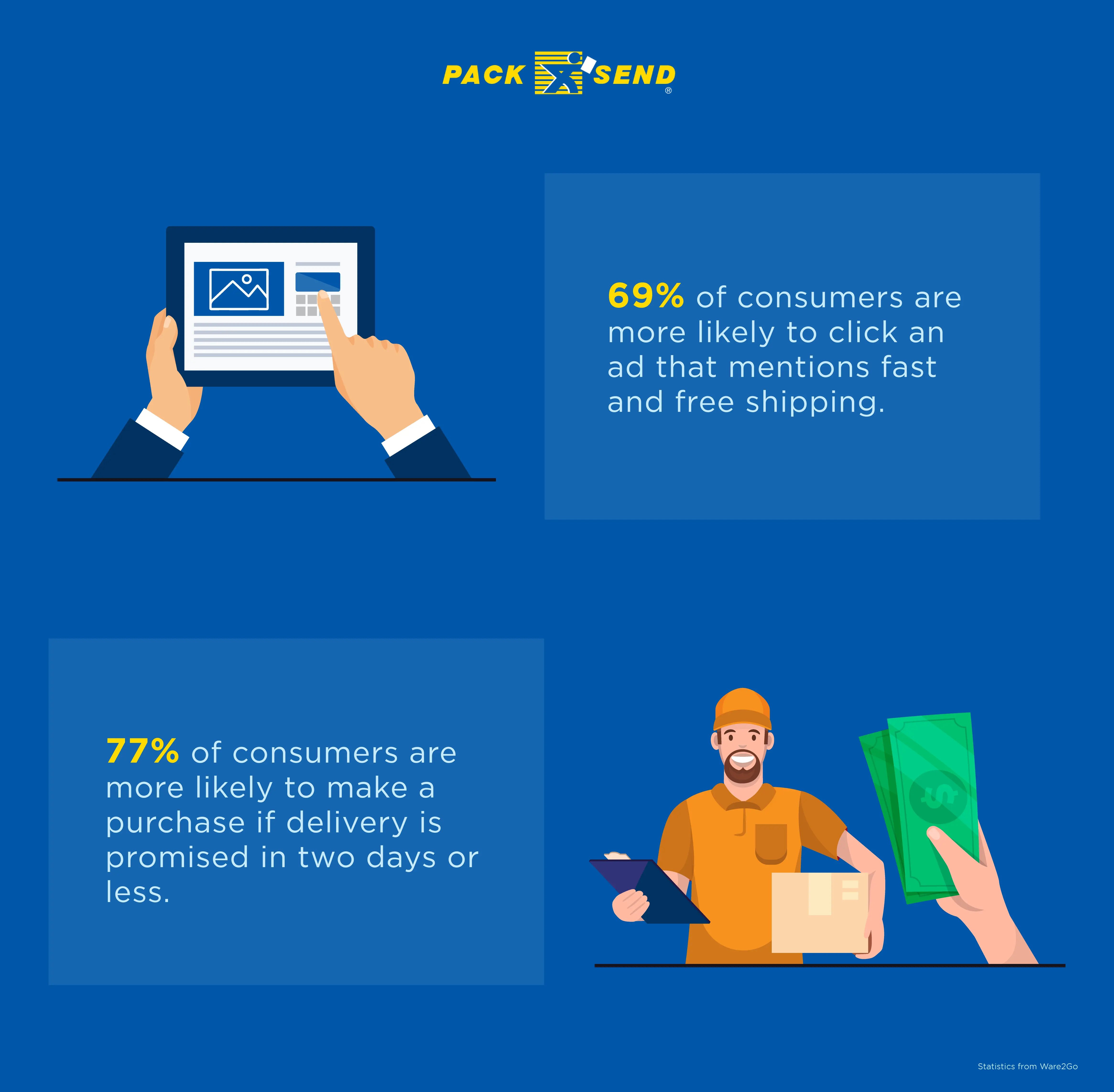
5. Customer Retention
If the majority of your customers demand fast delivery, you should make this a standard delivery option for your eCommerce store. If you don’t, you may end up losing valuable customers.
You don’t have to offer the quickest service out there. But if the time taken by your product to reach its final destination is too much higher than your competitors, you are likely to lose business.
6. Reduced Touchpoints
In order to fasten the delivery process, expedited shipping undergoes minimum halts and as minimum touchpoints as possible.
As expedited shipping carriers do not stop anywhere in the middle, it can help ensure safe delivery. Especially when COVID is prevalent.
7. Customer Satisfaction
Many times, customers mistake a shipping/delivery error as the seller’s responsibility — even if it is a carrier-related issue.
Expedited shipping annihilates this problem and allows you to provide a better experience to your customers.
This eventually leads to higher customer satisfaction ratings for your brand. Not only will the customers receive their deliveries more quickly, but the cost savings will reach them as well.
Challenges of Expedited Shipping
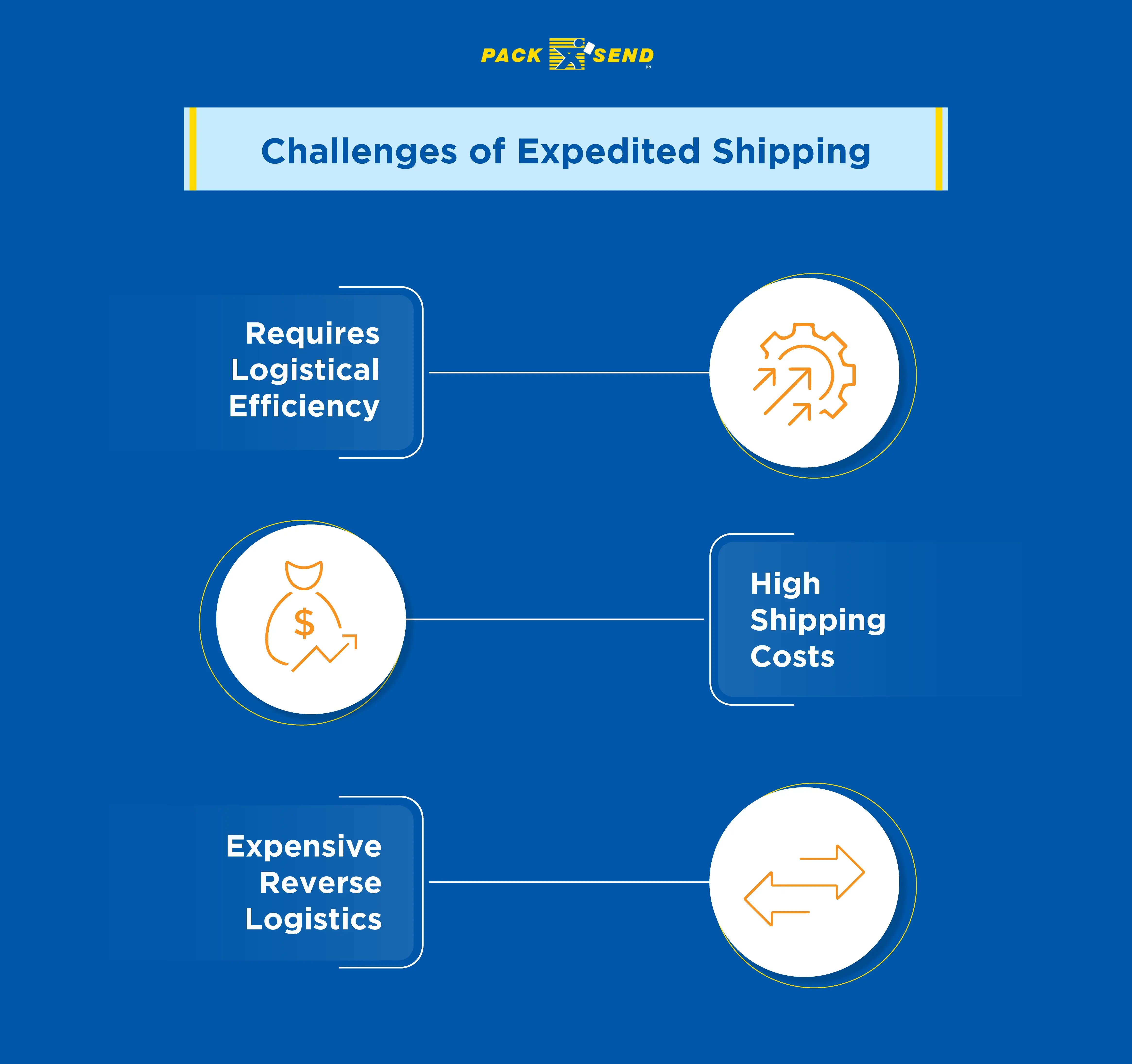
The benefits of expedited delivery pose a couple of challenges that every eCommerce business should be ready to face.
1. Requires Logistical Efficiency
An efficient logistics operation is the key to conducting seamless expedited shipping. You do not want your customers to get angry just because their order hasn’t arrived.
Logistics inefficiencies could result in:
- Lack of visibility
- Higher delivery costs
- Late deliveries
- Unsatisfied customers
An efficient logistics process offers unmistakable advantages like – streamlining operations, minimising downtime, adding value by getting products delivered quickly, etc.
Overcoming the Challenge
The easiest way to tackle this problem is to outsource your logistics and operational services. Your eCommerce business could benefit from partnering with the right logistic alliances, carrier contracts, or third-party fulfilment services.
It takes off the stress from your infrastructure, allowing delivery of your products consistently to customers.
Reliable logistics partners can ensure that the shipper’s urgent shipment is “on track” and develop a headache-free plan to get the goods where they need to go.
2. High Shipping Costs
Expedited shipping usually costs more than standard shipping, especially when reverse logistics are involved. Besides, there might not be many customers willing to pay for this extra expense. But it highly depends on multiple factors including the type of product, how soon the customer needs it, and where are they ordering it from.
Overcoming the Challenge
There are multiple ways to overcome this challenge including
- Setting up a minimum purchase threshold
- Displaying the expedited shipping option at the time of checkout
- Customising your expedited shipping policies
We’ll look at these solutions in detail in the later sections of this post. However, the simplest thing to do would be to offer different delivery options and have each customer choose the one they prefer.
3. Expensive Reverse Logistics
Returning products is not an uncommon thing for the eCommerce industry. The challenging part is to execute it successfully in the most cost-effective manner.
A reverse logistics process can sometimes take days and cost just as much as it cost to ship it in the first place.
Besides, if you’re taking care of the entire logistics process (including reverse logistics) on your own, the cost may get extremely hefty for you, not to mention the hassle. Especially when you’re providing free expedited delivery.
Overcoming the Challenge
The most cost-effective solution for this problem would be to outsource the entire shipping process to third-party providers. Third-party logistics providers (3PL) have robust networks and efficient processes in place for all types of delivery services.
Third-Party Logistics
3PL providers (also called third-party order fulfilment services providers) integrate all the services needed for shipping including receiving the goods, warehousing, packaging, and ensuring that it reaches the customers on time.
Expedited Shipping Best Practices
Whether you are shipping to another business or directly to a consumer, these expedited shipping best practices will surely come in handy:
1. Use Multiple Warehouses for Order Fulfilment
Anyone who knows how eCommerce fulfilment work knows that eCommerce operations rely on streamlined inventory. Hence, multiple warehouses and fulfilment centres come into play. It majorly depends on the production and location of your customer base.
Having multiple warehouses inherently makes your order fulfilment and logistics operations faster (and cheaper.) It makes it easier to ship to a wider area.
It makes the fulfilment accurate, efficient, and transparent. But the benefits extend far beyond that. Investing in multiple warehouses has a bevvy of other benefits too:
- It makes your processes cost-effective.
- The order can reach the customer at lightning speed.
- You can cater to more customers.
- Minimises the risks.
Putting into practice: As an example, let’s say you’re an eCommerce retailer. Your primary audience has historically been in Queensland, and your entire business operates from one warehouse.
Your robust domestic expedited shipping network allows you to ship across Queensland within two days.
Now your customer base has started expanding across the western parts of Australia with more customers opting for expedited deliveries.
Shipping orders all the way from Queensland to Western Australia on a daily basis, and that too on a priority basis doesn’t sound like a cost-effective solution. The natural solution would be to establish another warehouse in Western Australia itself.
2. Partner with a 3PL Provider
Sometimes it is better to outsource your logistics process and let the experts run your supply chain. External support from a third-party logistics provider brings efficiency to the processes and gives you a competitive advantage as well.
Role of 3PL Providers
Their primary role is to provide a cost-effective and time-effective solution for your supply chain operations. Integrated or bundled together, these third-party services allow goods to be created, stored and transported.
They’re deemed to be invaluable for eCommerce businesses as they assist your business through each step of the process. Some common reasons to opt for a third-party logistics provider include:
- To venture into new markets
- Creating positive customer experiences
- Expanding customer base, etc.
Here are some common logistics functions that can be outsourced to 3PLS:
Title: Types of 3PL Services
- Transportation
- Warehousing
- Reverse logistics
- Customs brokerage
- Trade show logistics
- Supply chain management
- Distribution
- White glove services
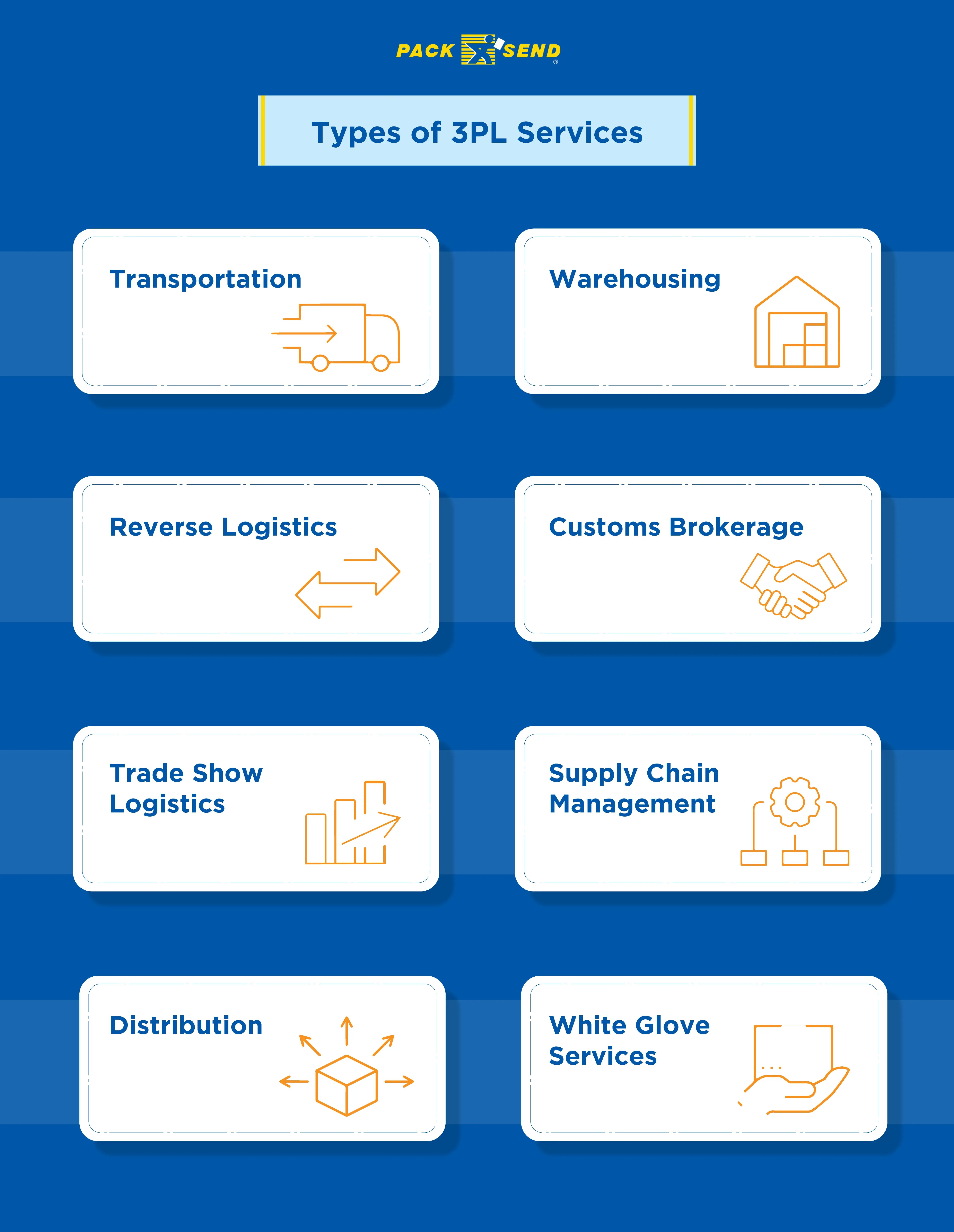
Putting into practice: For example, you’re a newly-fangled eCommerce business. The holiday season is near and you’ve reached a point where your daily orders quickly outgrow your distribution centres. Plus, you want to achieve same-day shipping on all the orders, even for the peak season order volumes.
It would be difficult to set up new infrastructure all of a sudden before the holiday season begins. The wise thing to do would be to partner with a third party provider who can fulfil your expedited shipping standards. You can take help with the packing, warehousing, and reverse logistics as well.
3. Set a Minimum Spend Threshold
Expedited deliveries are important but they should not cut your profits down. Especially if you’re offering it for free.
One way to offer expedited shipping while staying profitable is by setting a minimum spend threshold for customers to get eligible for expedited shipping.
You might have come across brands providing free expedited shipping only if you make a purchase for a certain amount.
This amount threshold is usually greater than the average order value (AOV) of that particular brand.

One of the best ways to put the expedited shipping offers in front of your customers is to add a shipping threshold counter on your website. Like this:
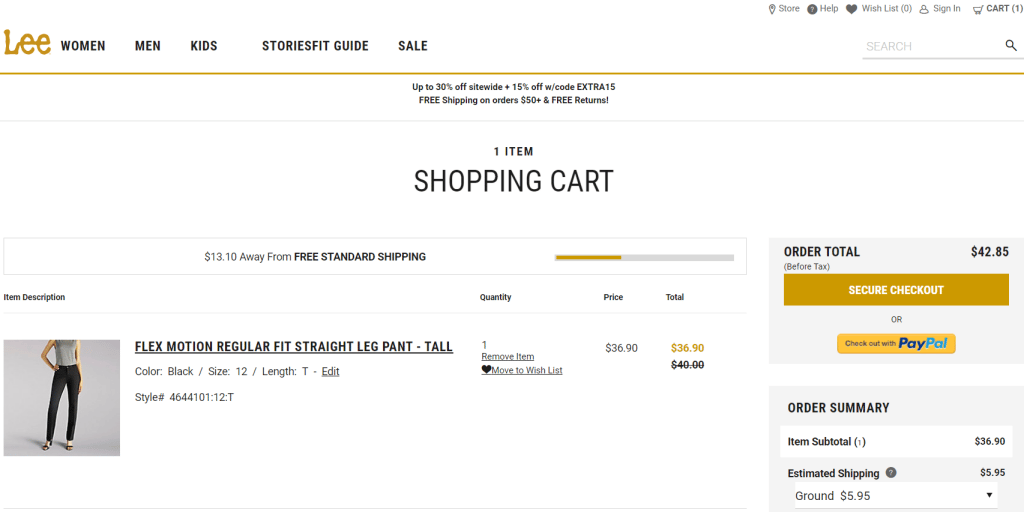
This counter will tell customers how much more they need to add to qualify for free expedited shipping. This is a powerful way to keep users engaged so that they don’t abandon their carts.
Average order value, and setting a minimum purchase threshold are paradoxical to each other.
Here’s how.
Putting into practice: Say you’ve figured out your eCommerce business’ average order value(AOV). Now you’re offering free expedited shipping on all orders with an amount greater than the AOV.
In order to qualify for this offer, the customers will shop for a greater amount. This in turn may increase the average order value of your sales. And the cycle keeps going. This creates a win-win situation for your business to profit from.
4. Display Expedited Shipping Options at Checkout
The easiest method to offer expedited shipping would be to display it along with various other shipping options at the time of checkout.
You can state the charges for all delivery options upfront along with the delivery ETA for each option.
Putting into practice: Here’s an example of how you can provide multiple shipping options at the time of checkout.
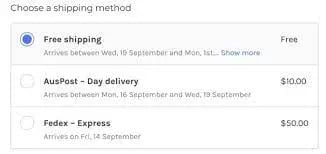
5. Pass the Bill to Customers
There would also be customers who straight-up want to buy your products without reaching the minimum order value.
And they would still want to receive it as quickly as they can.
Sometimes it may happen that they reach the end stage of the purchase journey and realise that the expedited delivery costs are much higher than they would be willing to pay. Sometimes even higher than the product itself.
To avoid such a scenario, you can add the expedited delivery charges before they reach the checkout stage.
The customers will need to opt for this long before checking out. This might be the most practical option for packages with large weight—and is likely necessary for longer-range deliveries.
A common way to offer expedited shipping on your eCommerce website is to display them through:
- Site banners
- Pop-up notifications
- Email newsletters, etc.
6. Customise Your Expedited Shipping Policy
Some businesses focus on geography, while others focus on the weight of goods they’re shipping.
A lot of businesses keep free expedited shipping limited only to nearby geographical locations. This helps them limit the cost of expediting the packages.
Some limit expedited shipping to just the most lightweight products so that the surcharge from the carrier isn’t too high.
You can simply mention upfront on your website whether the product is eligible for expedited shipping or not.
You can also create an exclusive list of “expedited shipping available” products that customers can order together to avail for free. Here’s an example:
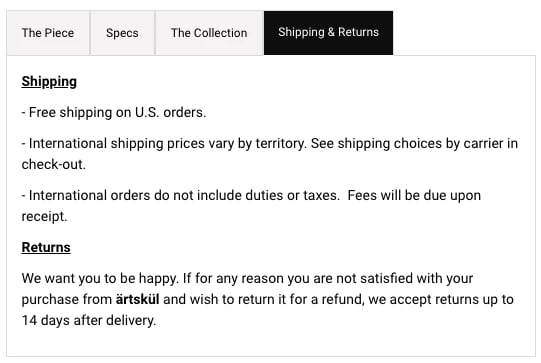
Putting into practice: Say you’re an eCommerce business based in the northern territory of Australia.
You have a cost-effective domestic expedited shipping process in place for same-day deliveries and never miss delivering a single order on time.
Say you get a couple of orders from the southern territory that is below the average order value of your eCommerce brand.
Trying to achieve a same-day delivery for this particular order would mean cutting down your profits.
There’s no point in doing so. In such a scenario, you can clearly mention the terms and conditions in your policies and ask for a fair delivery charge upfront if the customer from another location opts for same-day or expedited delivery.
7. Work With Multiple Carriers
Different shipping carriers have different express shipping options that you might want to use for the products.
While many of the “broad strokes” of their expedited delivery services might be similar, there may be some differences in other side services like package tracking.
It’ll also open more negotiation opportunities for you in terms of rates. You may be able to negotiate a more favourable rate with some carriers in your region than others.
Putting into practice: Say you have two carrier partners. You can list down their pros and cons and figure out which will work the best for what situation. Afterwards, you can narrow down your preferences based on the orders. For example,
- If the parcel weight is between 1 and 5 lbs, send it via carrier#1.
- If parcel weight is above 5lbs, send it via carrier#2.
Or you can differ in terms of the choice of freight. Based on the requirements and delivery ETA you can decide whether to ship it via road freight, air freight or sea freight.
You can also partner with different carriers for domestic expedited shipping and international expedited shipping.
You can also let your customers choose the carrier at the time of checkout. Like this:
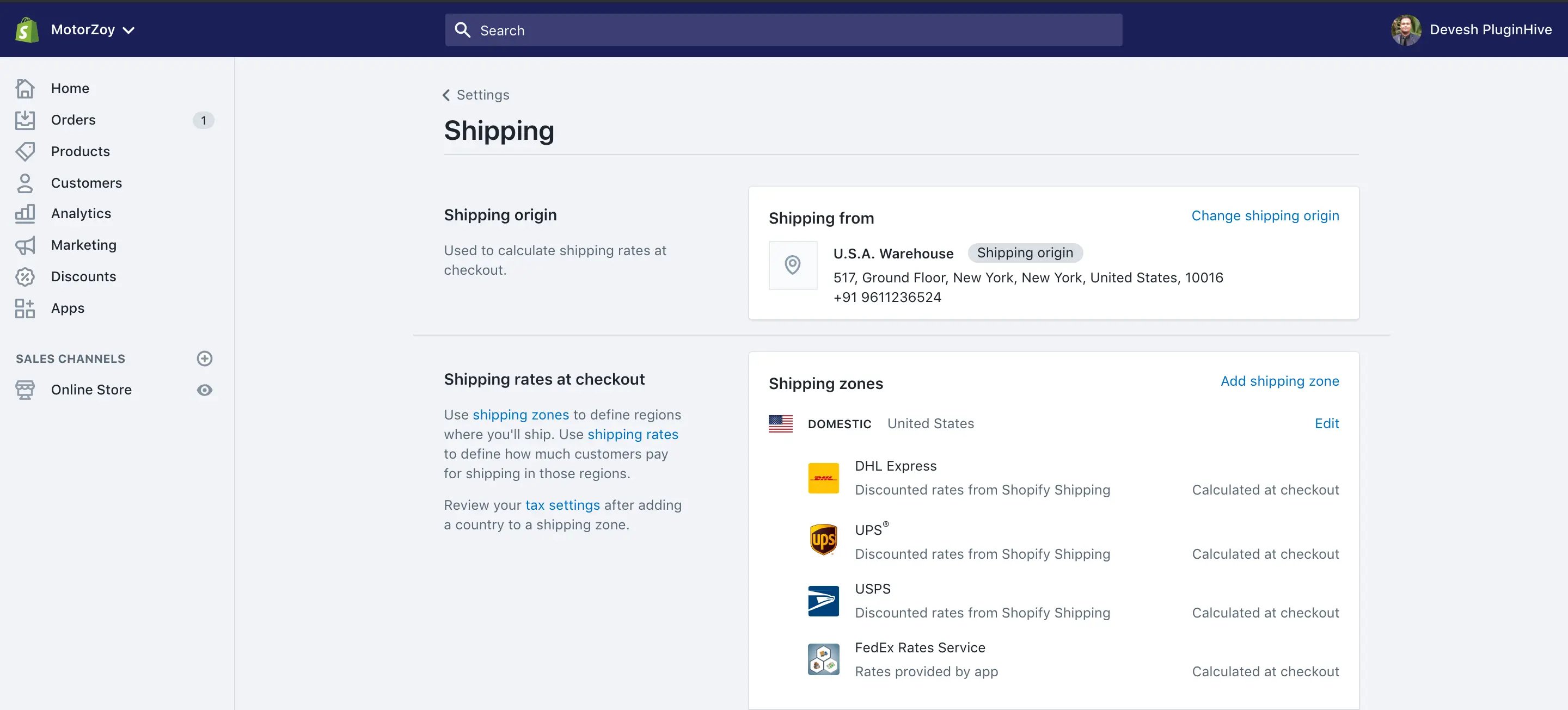
8. Leverage Flat Rate Boxes
Every package you send through expedited shipping need not be a custom shipping box. You can opt for carriers who offer flat rate boxes.
As long as the products you need to ship, fit in these boxes, there’s nothing more to worry about. It takes some of the guesswork out of managing costs. You can create bundle deals of products that neatly fit in these selected flat-rate boxes.
This is a good way to generate sales while making the most out of what you paid for the shipping!
The Bottomline
There’s no doubt that online retailers and eCommerce brands benefit from reduced delivery times. The immediate product access improves their position in the customers’ eyes as compared to stationary retailers.
The higher convenience and often lower prices are the major selling points here and make expedited shipping even more appealing. Expedited delivery brings both an immense opportunity and an operational challenge for eCommerce businesses.
Expedited shipping can play an integrated role in your supply chain with a dedicated, customised service that’s faster than any other brand. Start before expedited becomes the new “standard.” Work with the leading courier and logistics experts like Pack & Send to carry out approved, high-quality expedited shipping.
Frequently Asked Questions (FAQs)
What Does Expedited Delivery Mean?
In simple words, the expedited delivery meaning narrows down to a shipping option that gets a package to its destination faster than the standard delivery time.
For most businesses, expedited shipping means overnight or 2-day delivery. However, it depends on the carrier’s standard delivery. It also depends on where you ship from and where your customer is located.
What is Expedited Shipping?
Expedited shipping is a type of priority delivery service that promised to deliver goods to the customers within the span of three days.
The cost of expedited shipping is usually moderate to high as compared to the standard delivery options.
How Long Does Expedited Shipping Take?
The exact time taken for expedited shipping depends on the company and its shipping partners. The standard shipping often takes between 5 to 10 business days.
As compared to this, expedited shipping might get your package delivered in 3 to 4 days. However, usually most expedited shipping takes between 2 to 3 days.
How Much is Expedited Shipping?
The cost of expedited shipping depends on the type of expedited shipping you’re choosing.
If you’re opting for next-day delivery, it’ll be around 20 USD. If you’re opting for same-day expedited shipping, it’ll cost around 27 USD.
What is Express Shipping?
Express shipping is faster than expedited shipping and is also a lot more expensive.
The usual delivery time for express shipping is within 2 days. However, as consumers, you must pay close attention to both these options while shopping as they’re similar and used interchangeably. Each brand defines both these terms differently.
For example, Amazon promises a next day delivery when its customers opt for express shipping.
Image Sources: Amazon, Printful, BigCommerce, ärtskül, Pluginhive
